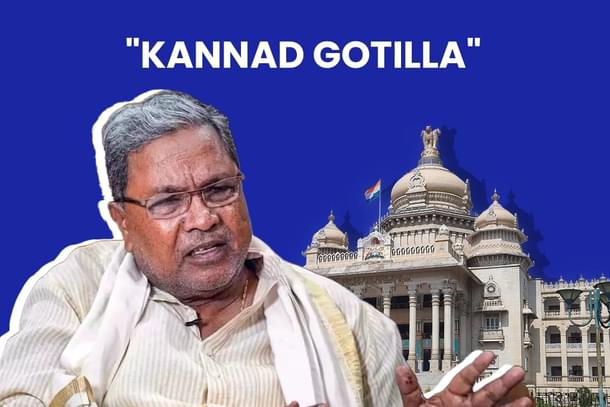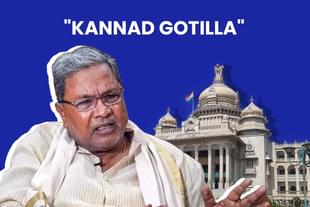Culture
Just Blaming Migrants Won't Do; How Karnataka And Other Southern States Can Make Their Languages More Accessible
S Rajesh
Jul 18, 2024, 06:48 PM | Updated Jul 19, 2024, 11:13 AM IST
Save & read from anywhere!
Bookmark stories for easy access on any device or the Swarajya app.


The Congress government's job reservation bill for Kannadigas in Karnataka, now on hold after a backlash, has understandably stirred up a debate.
Bengaluru's local residents are once again voicing concerns about the decline in Kannada culture in the city and migrants not making an effort to soak in the local language and culture.
While the concerns are well understood and migrants must really make the effort to learn Kannada, the debate must not ignore the fact that it is not easy for migrants to learn the language.
This difficulty is not limited to Karnataka alone; it is the same case in the other southern states — Kerala, Tamil Nadu, Telangana, and Andhra Pradesh.
What puts off many migrants from learning Kannada, Telugu, Tamil, or Malayalam is that they get intimidated by the script of the language.
Further, these languages sound different from the languages in the north, east, west, and northeastern parts of the country, which is where most people who are unable to pick up Kannada come from.
Therefore, instead of putting the blame entirely at the feet of migrants, it is high time southern states take steps to make it easier for people to learn their languages. Here are three ways:
Start Your Own Language 'Prachar Sabhas'
The southern states could consider starting prachar sabhas for their respective languages along the lines of the Dakshin Bharat Hindi Prachar Sabha.
The Dakshin Bharat Hindi Prachar Sabha, with which readers from outside the southern states may not be familiar, was initiated by Mahatma Gandhi in 1918. His son Devdas Gandhi was the first pracharak.
The idea behind setting up a prachar sabha was to use Hindi as a medium for national integration.
An oft-repeated counter to this idea is that since each southern state has its own language, how can someone from, say, Uttar Pradesh or West Bengal decide which language to learn.
The answer to that is simple. A lot of youngsters these days, especially those who want to have a career in technology, know that they might want to go to Bengaluru for jobs.
In urban parts of southern Bengal, for example, children of the middle and upper middle classes have mostly migrated to the south.
There it is common to hear, "Jaake dekho, oder chele-meye ra Bangalore chole geche. Bangalore na holey Hyderabad ba Chennai, kintu ekhane keo thaakchena. (Whoever we see, we find that their children have gone to Bengaluru. And if not Bengaluru, Hyderabad or Chennai. But no one is staying here.)"
That is enough of a trend and incentive to learn Kannada outside of the schooling system, just as a lot of people in the southern states learn Hindi out of their own interest from the Dakshin Bharat Hindi Prachar Sabha.
Offer South Indian Languages As An Option In School
While prachar sabhas can help people of all ages, it is important that languages are taught when children are younger.
Generally, it is easier to pick up a new language when someone is young. As people get older, the regular demands of the education system or work do not leave much time to learn a language, unless somebody is highly motivated to do so.
Therefore, in schools across the country, students should be provided with the option of learning any one language from a southern state. This would be in addition to existing options like Sanskrit and foreign languages like French and Spanish.
Navodaya Vidyalayas, for instance, have long had such an offering in place. The Vidyalayas in the Hindi-speaking states have partnerships with those in the non-Hindi-speaking states, and students are made to the learn the language of the partner states for a few years.
After that, there is an exchange programme in Class IX, thanks to which 30 per cent of the students get an opportunity to spend a year at the partner institution.
Southern States Can Lead By Example With Language Options
Tamil Nadu, which shares its borders with three other states, could, for instance, provide Telugu as a language option in the northern districts, like Tiruvallur and Vellore, which border Andhra.
Similarly, Kannada can be taught in districts like Krishnagiri, and Malayalam in Coimbatore, Theni, or Kanniyakumari.
The border districts have a large population of linguistic minorities and thus finding teachers would not be difficult.
The other parts of the state could similarly offer any language of their choice as an option.
Such steps would lead to a better understanding and appreciation of each other’s cultures and help ease the concerns that have been voiced in Bengaluru for years.
S Rajesh is Staff Writer at Swarajya. He tweets @rajesh_srn.





